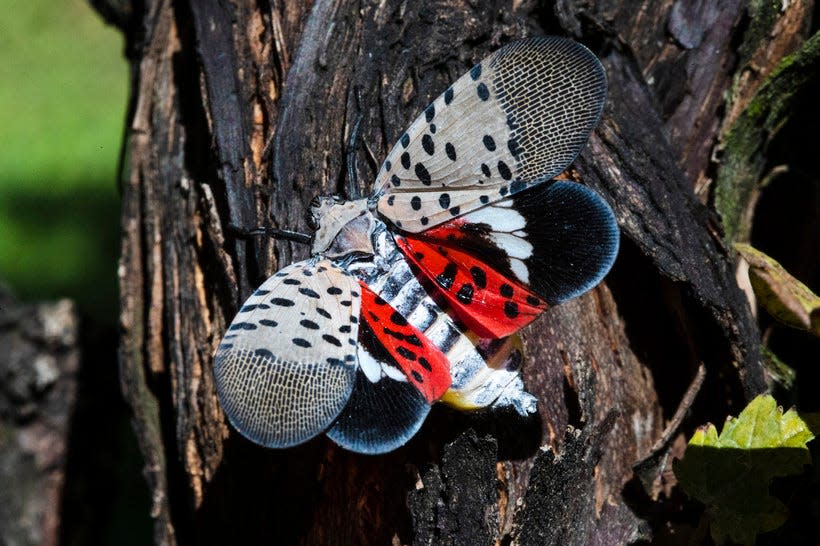Ken Baker: Controlling Tree-of-heaven's growth can control spread of spotted lanternflies

About 35 yards down the alley in back of my garage is a 60-foot import from China, a female Tree-of-heaven, Ailanthus altissima. She gets her common name from the extraordinary height she reaches in Asia, and decidedly not from any angelic personality.
The first specimens were brought to Philadelphia from Central China in 1784 as ornamentals, and by 1840 the species was found throughout much of the Northeast. Its ease of establishment, rapid growth, tolerance of pollution and poor soils, along with the absence of serious insect or disease problems, made it especially desirable as a shade tree for city streets.
Tree of heaven is no angel in the yard
However, the tree is a beast. Once established it commonly comes to dominate a site through its massive seed production, re-sprouting from old stumps, and secretion of plant toxins into the surrounding soils.
It’s a “dioecious” species with male and female flowers growing on separate plants. A fully grown female Ailanthus can produce upwards of 300,000 light, winged seeds per year that disperse far and wide with the winds of fall, winter and spring.
Which brings me back to my alley. Over the past three weeks, I’ve uprooted about a dozen seedlings from my backyard, and a walk around the block finds at least that many 6- to 10-foot saplings growing in untended gardens and cracks at the foundations of various buildings. They’re everywhere.
And, finally getting to today’s topic, that makes it “A wonderful day in the neighborhood,” as Mr. Rogers used to say, if you happen to be a spotted lanternfly looking for a new home.

Spotted Lanternflies now found in 14 states
In my last column, I discussed how spotted lanternflies (SLFs), another immigrant from China which were first discovered in southeastern Pennsylvania in 2014, can now be found in 14 states in the Mid-Atlantic, Northeast, and Midwest including Ohio where they are firmly established in eight counties. And there’s precious little reason to think they aren’t on track to own the state in a few years.
In Asia, several parasites keep SLF numbers pretty well in check, but with no natural enemies in North America, their abundance can skyrocket.
Two problems with that. First, the four larval stages feed on the sap from a wide variety of plants including, of great concern to vineyard owners, grape vines. Second, while the inch-long adults very much prefer to feed on the Tree-of-heaven, they’ll also attack black walnuts, red maples and many types of fruit trees.
And since females commonly lay their eggs on cars, trucks and trains, it’s not hard to envision the economic implications if and when the invader reaches the nation’s major fruit and wine production regions. Economic doomsday predictions aside, in areas of severe infestation, they are a major annoyance. They don’t bite, sting, or make a lot of noise, but their sheer numbers make it a lot less fun to be outside.
So, what are we doing about SLFs beyond the widespread advice to stomp on them and destroy their egg cases?How about those parasites that keep SLFs under control in China? Anastatus orientalis is a tiny wasp that parasitizes lanternfly eggs, and another wasp, Dryinus sinicus, attacks its larval stages. The problem of course is what if we release a non-native parasite and it alto attacks non-target species?
USDA studying how to battle lanternflies
Researchers at several USDA facilities have been conducting controlled laboratory studies on A. orientalis for some time, and the initial results aren’t promising. Of 36 tested North American insect species, the parasite laid eggs in 16. Work with D. sinicus is just beginning.
But here’s something. While citizen-survey results in Southeastern Pennsylvania (where SLF was first found) showed 17 times higher abundance between 2017-2019, they suggested a 41% drop between 2019 and 2021. Scientists in New Jersey have also observed lower numbers in 2023 than in 2022.
Are these real decreases in populations or is it just that people have gotten tired of reporting their observations to government agencies? Julien Urban, a professor of Entomology at Pennsylvania State University, has suggested that widespread efforts to eradicate Ailanthus trees, adult SLFs favorite food, may be having an impact.
Remember those plant toxins (quassinoids) the tree secretes into the soil? A 2018 study by South Korean researchers showed that adult lanternflies sequester them in their tissues and that the bad taste they give an SLF pretty much amounts to its only defense against predators.
Remember also the startling patch of red color on SLF hindwings they flash when disturbed? It’s generally considered a signal to birds and others about their chemical defense. But the warning wouldn’t have the guns to back up the threat without the Tree-of-heaven to feed on.
And that’s a powerful incentive for areas with heavy SLF infestations to get serious about eliminating Ailanthus. Not an easy task, as you can’t kill the Tree-of-heaven with a chainsaw; it just resprouts from its roots. But it is doable.You can find lots of devilish how-to guidance online.
Ken Baker is a retired professor of biology and environmental studies. If you have a natural history topic you would like Dr. Baker to consider for an upcoming column, please email your idea to fre-newsdesk@gannett.com.
This article originally appeared on Fremont News-Messenger: Ken Baker: Progress seen in controlling spread of spotted lanternflies

